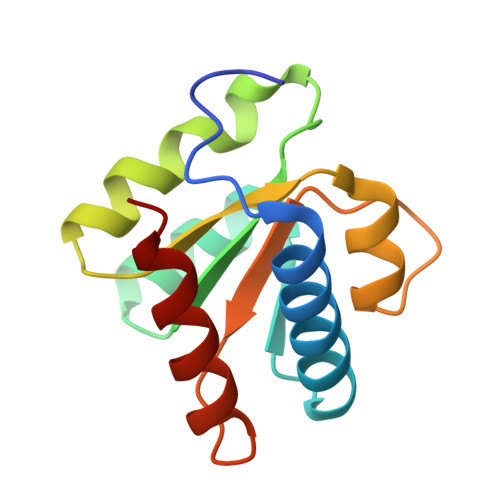Comparative analysis of the 15.5kD box C/D snoRNP core protein in the primitive eukaryote Giardia lamblia reveals unique structural and functional features.
Biswas, S., Buhrman, G., Gagnon, K., Mattos, C., Brown, B.A., Maxwell, E.S.(2011) Biochemistry 50: 2907-2918
- PubMed: 21366326
- DOI: https://doi.org/10.1021/bi1020474
- Primary Citation of Related Structures:
3O85 - PubMed Abstract:
Box C/D ribonucleoproteins (RNP) guide the 2'-O-methylation of targeted nucleotides in archaeal and eukaryotic rRNAs. The archaeal L7Ae and eukaryotic 15.5kD box C/D RNP core protein homologues initiate RNP assembly by recognizing kink-turn (K-turn) motifs. The crystal structure of the 15.5kD core protein from the primitive eukaryote Giardia lamblia is described here to a resolution of 1.8 Å. The Giardia 15.5kD protein exhibits the typical α-β-α sandwich fold exhibited by both archaeal L7Ae and eukaryotic 15.5kD proteins. Characteristic of eukaryotic homologues, the Giardia 15.5kD protein binds the K-turn motif but not the variant K-loop motif. The highly conserved residues of loop 9, critical for RNA binding, also exhibit conformations similar to those of the human 15.5kD protein when bound to the K-turn motif. However, comparative sequence analysis indicated a distinct evolutionary position between Archaea and Eukarya. Indeed, assessment of the Giardia 15.5kD protein in denaturing experiments demonstrated an intermediate stability in protein structure when compared with that of the eukaryotic mouse 15.5kD and archaeal Methanocaldococcus jannaschii L7Ae proteins. Most notable was the ability of the Giardia 15.5kD protein to assemble in vitro a catalytically active chimeric box C/D RNP utilizing the archaeal M. jannaschii Nop56/58 and fibrillarin core proteins. In contrast, a catalytically competent chimeric RNP could not be assembled using the mouse 15.5kD protein. Collectively, these analyses suggest that the G. lamblia 15.5kD protein occupies a unique position in the evolution of this box C/D RNP core protein retaining structural and functional features characteristic of both archaeal L7Ae and higher eukaryotic 15.5kD homologues.
Organizational Affiliation:
Department of Molecular and Structural Biochemistry, North Carolina State University, Raleigh, North Carolina 27695, United States.














